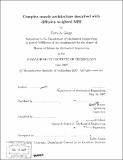| dc.contributor.advisor | Roger Kamm and Richard Gilbert. | en_US |
| dc.contributor.author | Gaige, Terry A. (Terry Alden), 1981- | en_US |
| dc.contributor.other | Massachusetts Institute of Technology. Dept. of Mechanical Engineering. | en_US |
| dc.date.accessioned | 2008-01-10T15:48:52Z | |
| dc.date.available | 2008-01-10T15:48:52Z | |
| dc.date.copyright | 2007 | en_US |
| dc.date.issued | 2007 | en_US |
| dc.identifier.uri | http://hdl.handle.net/1721.1/39867 | |
| dc.description | Thesis (S.M.)--Massachusetts Institute of Technology, Dept. of Mechanical Engineering, 2007. | en_US |
| dc.description | Includes bibliographical references (p. 89-98). | en_US |
| dc.description.abstract | The complex array of fiber orientations exhibited by muscles such as the tongue, esophagus, and heart, enable function beyond basic pulling. Among other things, the presence of crossing geometry adds the ability to push by bi-directional contraction causing expansion in the orthogonal direction. Diffusion weighted magnetic resonance imaging (DW-MRI), provides a convenient, non-destructive, method for deriving fiber architecture in many tissues. DW-MRI finely probes tissue microstructure by determining direction-specific variations of signal attenuation. Gradients are applied in a set of directions, intensities, and durations and the attenuation data combined to form an approximation of fiber alignment within each voxel. The main original contributions of this work are the calibration and application of diffusion weighted imaging methods to several muscular tissues and analysis of the data. Of particular note are: (1) the relation of diffusion spectrum MRI derived muscle architecture to 3D whole tissue two-photon microscopy data, and (2) the ability to capture mechanically relevant tongue muscle architecture data from human in vivo and analysis. | en_US |
| dc.description.abstract | (cont.) Muscular tissue is involved in nearly all vital functions of biological organisms: respiration, ingestion, digestion, circulation in addition to basic motion. The application of DW-MRI technologies to muscle tissue as described in this paper could lead to insights about or aid in the remediation of muscular dystrophies and other myopathies. | en_US |
| dc.description.statementofresponsibility | by Terry A. Gaige. | en_US |
| dc.format.extent | 98 p. | en_US |
| dc.language.iso | eng | en_US |
| dc.publisher | Massachusetts Institute of Technology | en_US |
| dc.rights | M.I.T. theses are protected by copyright. They may be viewed from this source for any purpose, but reproduction or distribution in any format is prohibited without written permission. See provided URL for inquiries about permission. | en_US |
| dc.rights.uri | http://dspace.mit.edu/handle/1721.1/7582 | |
| dc.subject | Mechanical Engineering. | en_US |
| dc.title | Complex muscle architecture described with diffusion weighted MRI | en_US |
| dc.type | Thesis | en_US |
| dc.description.degree | S.M. | en_US |
| dc.contributor.department | Massachusetts Institute of Technology. Department of Mechanical Engineering | |
| dc.identifier.oclc | 181592161 | en_US |
